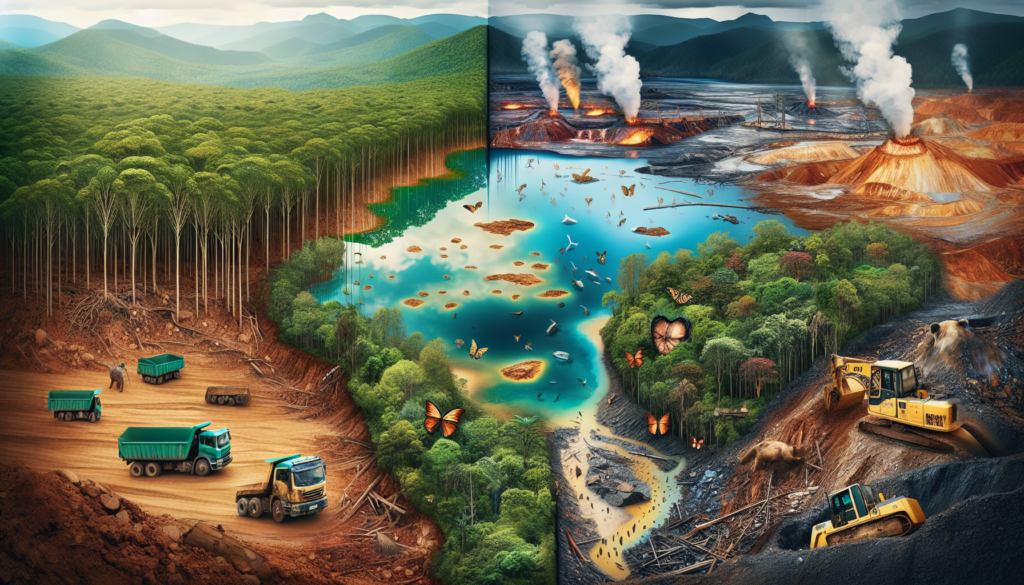In today’s article, we will explore the often overlooked topic of the environmental impact of gold mining. While gold has been coveted for centuries, the process of obtaining it comes at a significant cost to our planet. From habitat destruction and water pollution to the release of harmful chemicals, this article aims to shed light on the unseen consequences of gold mining. Join us as we delve into the environmental effects and their potential long-term implications. Brace yourself for an eye-opening journey into the dark side of one of the world’s most sought-after commodities.
1. Habitat Destruction
Gold mining has a significant impact on the environment, resulting in the destruction of habitats in various ways. Let’s explore the different aspects of habitat destruction caused by gold mining.
1.1 Deforestation
One of the most prominent environmental consequences of gold mining is deforestation. To extract gold, large areas of forests need to be cleared for mining operations. The machinery and equipment required for mining can cause widespread destruction of natural habitats, leading to the loss of countless trees and the disruption of ecosystems.
1.2 Loss of Biodiversity
The destruction of forests due to gold mining contributes to the loss of biodiversity. Forests are home to diverse species of plants and animals, and their destruction can lead to the extinction or displacement of numerous species. The delicate balance of ecosystems is disrupted, and the vital roles that various organisms play in these systems may be disturbed, causing severe ecological consequences.
1.3 Soil Erosion
Gold mining often involves the removal of topsoil and vegetation, leaving the land exposed to erosion. Without the protection of vegetation cover, heavy rainfall can wash away the fertile top layer of soil, leading to soil erosion. This erosion not only affects the mining site but can also result in sedimentation of nearby water bodies, causing further ecological damage.
1.4 Water Contamination
Gold mining activities can lead to water contamination, affecting both surface water and groundwater sources. The use of chemicals, such as cyanide, in the extraction process can result in the leaching of toxic substances into water bodies. These contaminants pose a serious threat to aquatic life and can also impact human health when they enter the drinking water supply.
2. Air Pollution
Gold mining operations also contribute to air pollution in several ways. Understanding these impacts can help us comprehend the overall environmental consequences of this industry.
2.1 Dust and Particulate Matter
Mining activities generate dust and particulate matter, which can spread over large areas, causing air pollution. Dust particles can irritate the respiratory system and contribute to respiratory diseases. Moreover, these particles can settle on the leaves of plants, hindering their photosynthetic capacity and impacting the overall ecosystem.
2.2 Mercury Emissions
Gold mining often involves the use of mercury to extract gold from the ore. This process releases mercury into the atmosphere, contributing to air pollution. Mercury is a highly toxic metal that can travel long distances through the air and settle in ecosystems, posing a significant risk to both wildlife and humans.
2.3 Sulphur Dioxide and Nitrogen Oxide Emissions
In addition to mercury emissions, gold mining can also release sulphur dioxide and nitrogen oxides into the atmosphere. These emissions result from the combustion of fuels, such as diesel, used in mining machinery. Sulphur dioxide and nitrogen oxides are major contributors to air pollution, causing respiratory issues and contributing to the formation of acid rain.

3. Water Pollution
Water pollution is another profound environmental impact of gold mining. The contamination of water bodies can have far-reaching consequences on aquatic ecosystems and human health.
3.1 Cyanide and Mercury Leaching
Gold mining involves the use of cyanide in the extraction process, which can lead to the leaching of this toxic substance into water bodies. Cyanide is highly poisonous and can cause serious harm to aquatic organisms. Similarly, mercury, often used in gold extraction, can also find its way into water sources, posing a significant threat to aquatic life and potentially entering the food chain.
3.2 Acid Mine Drainage
Another major concern with gold mining is the generation of acid mine drainage (AMD). When sulfide minerals present in the ore are exposed to air and water during mining, they can oxidize and produce acidic runoff. AMD can contaminate nearby water bodies, making them unsuitable for aquatic life and causing long-term damage to ecosystems.
3.3 Heavy Metal Contamination
Gold mining operations can result in the contamination of water bodies with heavy metals. These metals, such as arsenic, lead, and cadmium, are naturally present in the ore and can be released into the environment during mining processes. The accumulation of heavy metals in water bodies can have adverse effects on aquatic organisms and can ultimately lead to biomagnification up the food chain.
3.4 Disturbance of Aquatic Ecosystems
The contamination caused by gold mining can disturb aquatic ecosystems in various ways. Water pollution can directly harm fish and other aquatic organisms, causing population declines and even local extinctions. It can also disrupt the delicate balance within ecosystems, affecting the interactions between different species and impairing the overall health and functioning of aquatic habitats.
4. Deforestation
As mentioned earlier, deforestation is a direct consequence of gold mining. Let’s delve deeper into the impacts caused by the clearing of vegetation.
4.1 Clearing of Vegetation
To access gold deposits, large areas need to be cleared of vegetation. Forests, which are critical habitats that support diverse species, are often destroyed to make way for mining operations. The removal of trees not only robs countless organisms of their homes but also reduces the capacity of ecosystems to provide vital services such as carbon sequestration and erosion control.
4.2 Soil Erosion and Landslides
The removal of vegetation and topsoil during gold mining operations leaves the land vulnerable to erosion. Without the stabilizing roots of plants, heavy rainfall can easily wash away the exposed soil, leading to erosion. This erosion can further contribute to the sedimentation of nearby water bodies and increase the risk of landslides, posing dangers to both the environment and nearby communities.

5. Loss of Biodiversity
The destruction caused by gold mining significantly impacts biodiversity. Let’s explore the different aspects of biodiversity loss resulting from this industry.
5.1 Destruction of Habitats
The destruction of forests and other ecosystems due to gold mining directly destroys the habitats of numerous plant and animal species. Many species are unable to adapt quickly enough or find alternative habitats, leading to population declines and potential extinctions. The loss of habitats disrupts the intricate web of life, impacting ecological processes and overall ecosystem stability.
5.2 Displacement of Species
The clearing of vegetation and disturbance of habitats can force species to migrate, often disrupting their natural patterns. Animals dependent on specific plant species for food or shelter may struggle to find suitable alternatives, leading to population declines or local extinctions. The relocation of species can also have cascading effects on ecosystems, affecting the abundance and distribution of other organisms.
5.3 Fragmentation of Ecosystems
The destruction of habitats caused by gold mining often results in the fragmentation of ecosystems. Large-scale clearing of vegetation can create isolated patches of habitat, separated by mining areas or other forms of development. This fragmentation hinders the movement of species, restricts gene flow, and impedes the natural functioning of ecosystems. The loss of connectivity between habitats can lead to decreased biodiversity and reduced ecosystem resilience.
5.4 Impacts on Endangered Species
Gold mining can pose a significant threat to endangered species that inhabit the areas targeted for extraction. Endangered plants and animals that already face challenges in their survival struggle to cope with additional disturbances caused by mining activities. The loss of individuals or entire populations of endangered species can have irreversible consequences for their long-term survival and conservation efforts.
6. Soil Erosion
Soil erosion is a critical concern associated with gold mining activities. Let’s delve into the impacts and mechanisms behind soil erosion.
6.1 Removal of Vegetation Cover
During gold mining operations, the removal of vegetation is one of the first steps. This process not only destroys habitats but also exposes the soil to erosive forces. Without the protective cover of plants, rainwater can wash away the top layer of soil, carrying vital nutrients with it and leaving the land barren and susceptible to erosion.
6.2 Destabilization of Soil Structure
The physical disturbance of the land during gold mining operations, including excavation and waste disposal, can disrupt the structure of the soil. The compacted soil or loosened topsoil is more prone to erosion, as it lacks the natural stability provided by undisturbed soils. This destabilization accelerates the rate of soil loss, impacting the overall health and fertility of the land.
6.3 Sedimentation of Water Bodies
Soil erosion caused by gold mining often leads to the sedimentation of nearby water bodies. As eroded soil is carried into rivers, lakes, or streams, it settles at the bottom, reducing water quality and clarity. The buildup of sediment can smother aquatic habitats, disrupt the flow of water, and restrict the penetration of sunlight, negatively impacting aquatic organisms and altering entire ecosystems.
7. Contamination of Aquatic Ecosystems
The processes involved in gold mining can introduce toxic substances into aquatic ecosystems, leading to contamination with severe ecological consequences.
7.1 Introduction of Toxic Substances
Gold mining activities, particularly the use of chemicals in extraction processes, can introduce toxic substances into water bodies. Cyanide and mercury are two of the most prominent chemicals used, and their release into aquatic ecosystems can have catastrophic effects on aquatic life. These substances can accumulate in organisms, causing damage to their organs and impairing their ability to reproduce and survive.
7.2 Altered Ecological Balance
The introduction of toxic substances resulting from gold mining can disrupt the delicate ecological balance within aquatic ecosystems. The presence of these chemicals can lead to the decline or loss of certain species, while others may see significant population increases due to reduced competition or predation. Such disruptions can have cascading effects throughout the food web, ultimately impacting the overall health and functioning of aquatic ecosystems.
7.3 Impact on Aquatic Organisms
Aquatic organisms, ranging from fish to invertebrates and microorganisms, are directly affected by the contamination resulting from gold mining operations. Exposure to toxic substances like cyanide and mercury can cause deformities, reproductive issues, and even death in these organisms. The loss of key species within aquatic ecosystems can have profound implications for the entire ecosystem, leading to imbalances and potential collapses in the long run.
8. Health Risks for Communities
The environmental impacts of gold mining also extend to human health, particularly for communities living near mining sites. Let’s examine some of the health risks associated with gold mining.
8.1 Exposure to Mercury and Cyanide
Communities near gold mining sites may face exposure to toxic substances such as mercury and cyanide. These substances can contaminate local water sources, making them unsafe for drinking and domestic use. Prolonged exposure to mercury and cyanide can have severe health effects, including neurological disorders, reproductive problems, and increased cancer risks.
8.2 Respiratory Issues from Air Pollution
Air pollution resulting from gold mining activities can also impact the health of nearby communities. The release of dust and particulate matter into the air can lead to respiratory issues, especially for those with pre-existing conditions such as asthma or chronic obstructive pulmonary disease (COPD). Prolonged exposure to air pollutants can exacerbate respiratory symptoms and affect lung function.
8.3 Waterborne Diseases
Contaminated water sources resulting from gold mining can increase the risk of waterborne diseases among nearby communities. The presence of toxic substances, pathogens, and pollutants in drinking water can cause illnesses such as gastrointestinal infections, skin diseases, and parasitic infections. These waterborne diseases can have both short-term and long-term impacts on the health and well-being of affected individuals.
9. Land Degradation
Gold mining often leads to land degradation, impacting the environment beyond the immediate mining areas. Let’s delve into the different aspects of land degradation caused by this industry.
9.1 Vast Open Pits
Gold mining involves the excavation of vast open pits, leaving behind scars on the land. These massive pits disrupt the natural landscape and can be a permanent alteration to the local environment. The creation of open pits not only destroys habitats but also poses additional risks such as safety hazards and potential water pollution if adequate measures are not taken to manage them properly.
9.2 Acid Soils
Acid mine drainage, resulting from sulfide oxidation during gold mining, can lead to the formation of acid soils in surrounding areas. The acidic nature of these soils makes them unsuitable for many plants, reducing the potential for the land to recover and regenerate. Acid soils can further contribute to the degradation of land and limit the chances of ecosystem recovery in post-mining landscapes.
9.3 Desertification
Gold mining can also exacerbate the process of desertification in certain regions. The removal of vegetation and the disturbance of the soil can affect the natural water cycle, leading to reduced water retention and increased evaporation. These changes, coupled with soil erosion, can contribute to the desertification of previously fertile lands, further exacerbating the loss of habitats and biodiversity.
10. Climate Change
Gold mining contributes to climate change through various mechanisms, linking this industry to global environmental issues. Let’s explore the impacts of gold mining on climate change.
10.1 Greenhouse Gas Emissions
Gold mining operations contribute to greenhouse gas emissions, primarily through the use of fossil fuel-based energy sources. The machinery and equipment used in mining require significant amounts of energy, often derived from fossil fuels like diesel and coal. The burning of these fuels releases greenhouse gases, such as carbon dioxide, into the atmosphere, contributing to global warming and climate change.
10.2 Deforestation and Loss of Carbon Sinks
The destruction of forests during gold mining contributes to climate change by reducing the capacity of ecosystems to act as carbon sinks. Forests are vital in absorbing carbon dioxide from the atmosphere through photosynthesis and storing it in their biomass. However, deforestation disrupts this process, releasing large amounts of stored carbon into the atmosphere and reducing the overall capacity of ecosystems to mitigate climate change.
In conclusion, gold mining has far-reaching environmental impacts. From habitat destruction and loss of biodiversity to air and water pollution, the consequences of this industry are significant and affect both the natural world and the communities living near mining sites. Being aware of these impacts is crucial in developing sustainable practices and finding ways to mitigate the environmental damage caused by gold mining.

